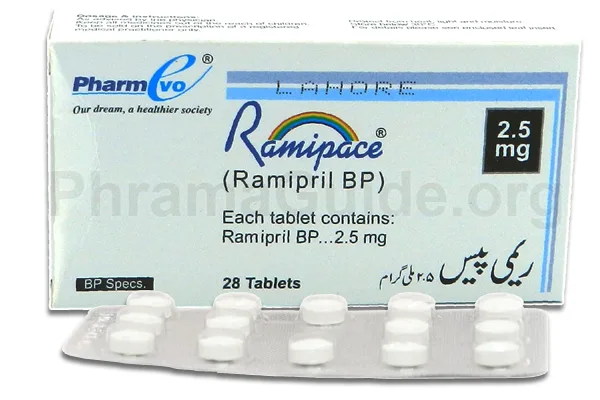Ramipace tablet belongs to the class of drugs known as angiotensin-converting enzyme (ACE) inhibitors. It is primarily used to treat hypertension and other cardiovascular conditions, including:
- Hypertension (High Blood Pressure): Ramipace tablet is commonly used for the treatment of hypertension. It helps lower blood pressure by inhibiting the enzyme ACE, which is responsible for the conversion of angiotensin I to angiotensin II. By reducing the production of angiotensin II, Ramipace relaxes and dilates blood vessels, leading to a decrease in blood pressure.
- Heart Failure: Ramipace tablet is also used in the management of heart failure. It helps improve heart function and reduce symptoms by dilating blood vessels and reducing the workload on the heart.
- Prevention of Cardiovascular Events: Ramipace tablet is sometimes used for individuals at high risk of cardiovascular events, such as heart attack or stroke. It has been shown to reduce the risk of these events in patients with a history of cardiovascular disease or certain risk factors. It can help protect the heart and blood vessels by improving blood flow and reducing the strain on the cardiovascular system.
- Diabetic Nephropathy: Ramipace tablet is used in the management of diabetic nephropathy, a kidney disease that can occur as a complication of diabetes. It helps delay the progression of kidney damage and reduce proteinuria (excessive protein in the urine) in individuals with diabetes.
- Post-Myocardial Infarction (Heart Attack) Care: Ramipace tablet is often used as part of the treatment regimen following a myocardial infarction (heart attack). It helps improve outcomes and prevent future cardiovascular events in individuals who have had a heart attack.
Off-label Uses Of Ramipace Tablet
- Migraine Prevention: Ramipace tablets may be used off-label in preventing migraines. It is believed that it has the ability to dilate blood vessels and improve blood flow may contribute to its potential migraine-prevention properties.
- Renal Protection in Diabetes: Ramipace is sometimes used off-label in individuals with diabetes to provide renal protection. It may help slow the progression of diabetic kidney disease and reduce the risk of kidney complications.
- Raynaud’s Phenomenon: Raynaud’s phenomenon is a condition characterized by episodic narrowing of blood vessels in response to cold or stress, leading to reduced blood flow to the fingers and toes. Ramipace may help improve symptoms in individuals with Raynaud’s phenomenon by dilating blood vessels and improving blood circulation.

What is Ramipace?
Ramipace is one of the leading brands of Ramipril, manufactured and marketed by Pharmevo Pakistan (Pvt) Ltd.
Ramipace Alternatives : Other Similar Brands
The following are some available alternative brands of Ramipace and their manufacturers.
- Tritace : Sanofi Aventis (Pakistan) Ltd.
- Hiace : Himont Pharmaceuticals (Pvt) Ltd, Pakistan.
- Ramy : Getz Pharmaceuticals (Pvt) Ltd, Pakistan.
- Lipra : Park Davis & Company Ltd.
- Hyperace : Werrick Pharmaceuticals, Pakistan
- Mevlon : Helix Pharma (Pvt) Ltd, Pakistan.
- Normipil : Standpharm Pakistan (Pvt) Ltd.
- Ramiscot : Scotmann Pharmaceuticals, Pakistan.
- Ramipraz : Fozan Pharmaceuticals Industries (Pvt) Ltd, Pakistan.
- Ramoril : English Pharmaceuticals Industries, Pakistan.
Ramipace : Available Formulations and Strengths
Presently, Ramipace is available in Tablet Form with the following strengths.
Ramipace Tablets : 1.25mg, 2.5mg, 5mg, and 10mg strengths.
Who Should Not Use Ramipace?
Ramipace has certain contraindications, which are specific situations or conditions where the use of Ramipace is not recommended due to the potential risks outweighing the potential benefits.
Hypersensitivity: Ramipace is contraindicated in individuals who have a known hypersensitivity or allergy to Ramipace or any other ACE inhibitors. Signs of hypersensitivity may include rash, itching, swelling, severe dizziness, or difficulty breathing.
History of Angioedema: Ramipace is contraindicated in individuals with a history of angioedema (swelling of the face, lips, tongue, or throat) related to previous ACE inhibitor use. ACE inhibitors can rarely cause angioedema, and individuals with a history of this reaction are at higher risk of experiencing it again.
Bilateral Renal Artery Stenosis or Single Kidney: Ramipace is contraindicated in individuals with bilateral renal artery stenosis (narrowing of both renal arteries) or those with a single functioning kidney. It can cause a decrease in renal function in individuals with these conditions, leading to potentially severe kidney problems.
Pregnancy: Ramipace is contraindicated during pregnancy. It can cause harm to the developing fetus and may lead to serious complications, including birth defects and fetal death.
History of Hereditary Angioedema: Ramipace should be used with caution or avoided in individuals with a history of hereditary angioedema. It can trigger or worsen angioedema in individuals with this inherited condition.
Severe Liver Impairment: Ramipace is contraindicated in individuals with severe liver impairment. It is primarily metabolized in the liver.
What is the Recommended Daily Dosage of Ramipace?
Ramipace Dose for Hypertension (High Blood Pressure):
- One Tablet of 2.5mg once daily. Depending on the individual’s blood pressure response.
- The dose may be gradually increased to a maintenance dose of 5mg or 10mg tablet once daily.
Ramipace Dose for Heart Failure:
- One Tablet of 1.25mg once daily, and it may be increased gradually to the target maintenance dose.
- The maintenance dose can range from 2.5mg to 10mg tablet once daily, depending on the individual’s tolerance and response.
Ramipace Dose for Post-Myocardial Infarction (Heart Attack) Care:
- Starting dose: One Tablet of 2.5mg once daily, and it may be increased gradually.
- Maintenance dose: One Tablet of 5mg or 10mg once daily.
How Ramipace Works?
Ramipace is an angiotensin-converting enzyme (ACE) inhibitor that exerts its mode of action primarily by inhibiting the activity of ACE. ACE is an enzyme responsible for the conversion of angiotensin I to angiotensin II.

Leave A Comment